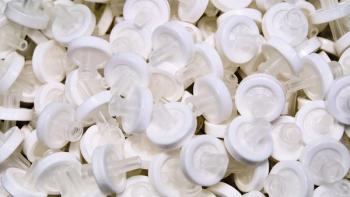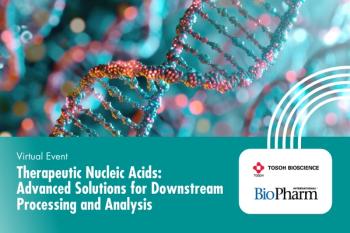
- BioPharm International-10-01-2020
- Volume 33
- Issue 10
Cell Harvesting Steps Separate the Good from the Bad
A balance must be achieved between debris and impurity removal and maximizing product quality and yield.
Upstream and downstream bioprocessing operations are linked via the cell harvesting step. Cell harvesting is a crucial unit operation involving the removal of cells, cell debris, and other soluble and insoluble impurities that are detrimental to subsequent chromatographic separation processes.
Proper choice of harvesting technology is essential; the results of this step impact all following purification operations. The technology chosen must match the characteristics of the upstream cell-culture process (adherent or suspension, high or low titer, etc.) and the nature of the product (proteins, viruses, cells, etc.) while providing bioprocess fluids suitable for subsequent required purification steps. The most appropriate harvesting technology will also accommodate the inevitable batch-to-batch variations that occur with cell culture processes.
Increasing cell densities and process volumes
The biggest challenges to successful harvesting can be attributed to increases in productivity of cell culture processes. “In recent years, significant advancements in upstream processes have resulted in creating bottlenecks in clarification when approached by traditional means,” says Darren Verlenden, head of bioprocessing at MilliporeSigma.
Cell densities and product concentrations, for instance, are increasing as cell culture processes become more intensified, according to Susan Prochazka, application specialist for separations at Sartorius. Greater maximum filter areas and, therefore, production plant footprints are required.
One example is handling cell densities of greater than 20 million cells/mL, which is common with high-titer processes. “High cell density processes often come with increased impurities including DNA, host cell proteins, and cellular debris, which can wreak havoc on the downstream processes,” Verlenden explains. An optimal harvest clarification, he adds, can be instrumental in the removal of these impurities to alleviate challenges that high-density feed streams can exact further downstream.
In some cases, such as for viral vector and other virus production processes, choosing the right time to harvest can enable higher product recoveries while minimizing cell debris. For others that involve cell disruption to isolate intra-cellular products, a significant amount of cell debris, as well as debris of varying sizes, is produced that can challenge depth filers and potential sterile filters as well, Prochazka adds.
As a result, it is important to have the ability to predict optimal harvest filter trains from measurable feedstream properties, according to Magnus Schroeder, vice-president of process development with Avid Bioservices. “The overall goal is to minimize product losses and cell damage while maximizing impurity removal. The best approach to achieving this goal is to identify high-capacity, high-throughput harvest solutions that are highly scalable and robust with respect to relevant changes in the feedstream properties using data generated at lab scale,” he asserts.
Suspension vs. adherent cell culture
While suspension cell culture is generally preferred and most new bioprocesses use this approach, there are still many processes that involve adherent cell culture either because they were initially developed that way or because of the nature of the cells involved. Small-scale adherent cell-culture processes have traditionally been performed in roller bottle or cell tray formats, but they do not scale well. Larger adherent cell-culture processes employ microcarriers to provide adherent support for the cells within existing upstream suspension platforms or are performed in fixed-bed bioreactors.
For cell harvesting, in most cases adherent cell-culture processes present fewer challenges because the supernatant contains less cell debris and often can be filtered directly through a bioburden reduction-grade filter or sterile-grade filter, according to Prochazka. She does note, though, that many of these processes involve viruses or viral vectors, which tend to adhere more to depth filters due to their charged nature.
For processes that rely on microcarriers, the cells are typically released by exposing them to an enzyme such as trypsin for a short incubation period. Expertise is needed to find the right concentration of trypsin and incubation time to not damage or kill the cells due to over-exposure, according to Peter Molloy, executive vice-president of Orgenesis. “We are overcoming some of these challenges by developing novel biodegradable microcarriers,” he notes.
The free microcarriers can then be removed downstream using fully synthetic large-capacity gradient filters followed by a suitable secondary polishing depth filter, according to Verlenden. For adherent processes performed in fixed-bed reactors, meanwhile, clarification may be focused on cell debris and impurity removal using an intermediate grade and polishing depth filter.
Although suspension cell-culture processes are more scalable, cell harvesting can be challenging as well because finding the right technique is based on the density and type of cells being harvested, Molloy says. He notes that common filtration approaches include centrifugation, microfiltration, depth filtration, and membrane filtration, or a sequential combination of these techniques.
Typically, Verlenden adds, cell harvesting for a suspension cell-culture process would involve a two-stage clarification train consisting of a primary and secondary step, or a pre-treatment technology to further enhance clarification performance. It is for these processes in particular that increasing cell and product densities can lead to increased filter areas and therefore process costs and footprints, Prochazka observes.
Cells as the product
When the cells themselves are the product, cell harvesting can be quite challenging. Unlike for the bulk of traditional processes, where cells need to be discarded at the end of the cell culture, in cell therapy, the objective is to harvest the cells with the greatest of care. “Cells are fragile and can be highly shear sensitive, however,” Molloy says. It is therefore important to take into consideration the density and viability of the cells, and ensure minimal disruption during harvesting. Lysis, he adds, must also be prevented to avoid potential cell death.
Given that the sensitivity of the cells is the central challenge, they should be harvested using techniques that have extremely low shear forces and high product recovery rates, according to Prochazka. She points to a single-use continuous centrifugation system offered by Sartorius that maintains the cells in a fluidized bed where they can be concentrated or medium can be exchanged in a non-invasive way compared to a conventional centrifuge. “This approach is also beneficial because it can be operated under sterile conditions, which is important given that sterile filtration cannot be performed due to the large size of cells,” she observes.
Acoustic wave technology is another effective solution that is scalable, reduces costs, and improves quality, according to Verlenden. MilliporeSigma has developed a solution based on this technique that he says provides a gentler, efficient, closed, and automated system as an alternative to current mechanical and filtration methods for cell harvesting.
Unique approaches required
Cell culture clarification is essentially a fine balance between removing debris and impurities while ensuring high product quality and yield. Because each process and product has unique characteristics, each modality and cell line requires a unique cell harvest and clarification approach, according to Verlenden.
“Over the years, the industry has gained significant expertise in handling monoclonal antibody (mAb) processes; however, as novel modalities continue to gain market share along with the adoption of non-Chinese hamster ovary expression systems (plant cells, microbial, insect), it may require investigation and evaluation of novel clarification approaches, including the addition of flocculants to pretreat the feed stream at the bioreactor,” Verlenden says.
For instance, Schroeder points outs that for some complex recombinant protein and low isoelectric point antibodies, product binding to depth filter matrices, and thus yield loss, must often be considered. Adsorption is also a challenge for other charged actives, including viral vectors and other virus-based products and RNA-based drug and vaccine substances, due to higher levels of interaction with filter materials, Prochazka reiterates. A closed and sterile clarification step may also be needed to ensure operator safety and product sterility for some of these products, she adds. When single-use systems are employed, consumable quality and compatibility must also be addressed.
Meanwhile, the shift to intensified manufacturing is generating a need for continuous harvesting techniques, according to Prochazka.
Innovative solutions address many challenges
The increasing necessity to harvest products from high cell-density cultures while maintaining or improving product yield has led companies to turn to innovative solutions for clarification of cultures, including single-use devices, high-capacity depth filters, and pretreated feed streams.
“Improvements in clarification depth filtration, including high capacity filters with gradient filter media to support increased throughput with minimal breakthrough, fully synthetic filters, and depth filters optimized for pretreated feed streams benefit large-scale manufacturing due to the lower quantity of depth filters required to achieve similar efficiencies compared to traditional primary and secondary filtration systems,” Verlenden asserts.
In addition to synthetic depth filter matrices, hybrid filter formats and additional pre-processing steps such as flocculation and filter aids can add value in terms of productivity, throughput, and additional impurity removals, Schroeder agrees. “While increasing cell culture productivities largely achieved by increases in cell mass can present challenges with respect to depth filtration capacity, alternative formats such as flocculation and filter aids can help to overcome those capacity constraints by increasing the filter capacity,” he says.
Sartorius has focused on developing single-use sterile manifolds that can continuously process material from large-scale, high cell-density mAb processes and cell therapies with working volume ranging from 0.5 L to 50 L, both with high recovery rates.
Prochazka notes that switching from capsules to cassette format for cellulose-based depth filtration allows for easy scale up and set up in a low footprint despite increasing batch volumes. However, where depth-filtration is not appropriate for clarifying high cell-density-cultures, Sartorius is focusing on using a centrifuge with single-use sterile manifolds. These systems, according to Prochazka, can continuously process material from high cell-density mAb processes up to 2000 L and cell-therapy processes with working volumes down to 500 mL, both with high recovery rates while employing low shear forces.
More advances to come
Some of the newer technologies in use today for cell harvesting are expected to benefit from further improvements in the near future. Refinements of depth filtration technology through the addition of tailored functional groups that enable combined solid/colloid removal capacity with improved impurity removal will, according to Schroeder, reduce the burden on purification steps further downstream and potentially reduce the number of total purification steps required to achieved final product quality specifications.
Improved pre-treatment solutions for the flocculation of cells and cell debris are expected by Verlenden. This technology, he notes, allows for the aggregation of smaller particles that are difficult to centrifuge and may plug traditional downstream filters. “Pre-treatment offerings, including cationic flocculation polymers in conjunction with charged depth filters with gradient density structures, are specifically designed to manage the particle size distribution, and improve the process consistency and efficiency of clarification steps by reducing soluble process impurities such as host cell proteins and host cell DNA,” he says.
Some older, alternative technologies for cell harvesting are also being revisited, according to Prochazka. She points to sedimentation techniques in combination with precipitation or flocculation as promising for very high biomass loads.
Like Prochazka, Verlenden also expects the adoption of single-use technologies at commercial scale to continue in response to demand for production efficiencies and closed, intensified, and continuous processing. “Single-use technologies are becoming widely adopted for cell separation and downstream applications, offering benefits including minimized cross contamination of products, reduced process time and operation costs, increased productivity, and improved quality,” he asserts.
About the Author
Cynthia A. Challener, PhD, is a contributing editor to BioPharm International.
Article Details
BioPharm International
Vol. 33, No. 10
October 2020
Pages: 28–30
Citation
When referring to this article, please cite it as C. Challener, “Cell Harvesting Steps Separate the Good from the Bad," BioPharm International, 33 (10) 2020.
Articles in this issue
about 5 years ago
Navigating Cell Therapy Manufacturing Amid Pandemic Woesabout 5 years ago
Reimagining Affordable Biosimilarsabout 5 years ago
Reconfiguring Fill/Finish Inspection to Meet COVID-19 Vaccine Goalsabout 5 years ago
Glycoengineering Shows Promise for Enhancing Antibody Therapeuticsabout 5 years ago
Assessing Data Integrity Risks in an R&D Environmentabout 5 years ago
Streamlining Method Transfer Across Global Sitesabout 5 years ago
Avoiding the GMP Bottleneckabout 5 years ago
Will COVID-19 Pandemic Finally Establish Drug Quality Metrics?about 5 years ago
The (Dis)Information PandemicNewsletter
Stay at the forefront of biopharmaceutical innovation—subscribe to BioPharm International for expert insights on drug development, manufacturing, compliance, and more.





